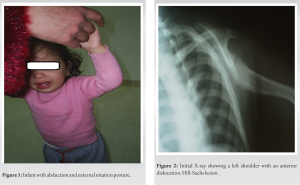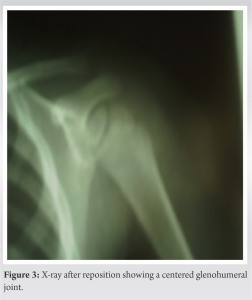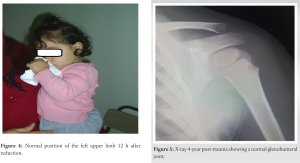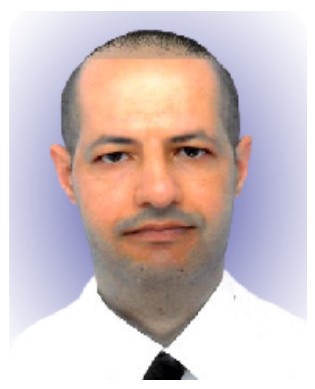Traumatic shoulder dislocation in toddlers is a rare phenomenon with a distinct mechanism from that observed in adults. This report highlights the importance of this entity in children and provides an overview of their management and outcomes.
Dr. Yahia Aloui, Department of Trauma and Orthopedics, Orthopaedic Division, Sahloul Teaching Hospital, Faculty of Medicine, University of Sousse, Sousse, Tunisia. E-mail: yayaaloui14@gmail.com
Introduction: The traumatic dislocation of the shoulder in a toddler is rare and is typically observed in children with neuromuscular issues. The treatment approach for this condition is extrapolated from that of shoulder dislocations in adults and teenagers. The primary complication is recurrence.
Case Report: We present the case of a 20-month-old infant with no significant medical history, who experienced a post-traumatic pure luxation of the left shoulder. The dislocation was successfully reduced under general anesthesia, followed by immobilization in a short sling for 3 weeks. Four years post-treatment, there was no recurrence, and the shoulder remained stable with complete mobility.
Conclusion: While uncommon, traumatic shoulder luxation in toddlers should be considered in the presence of functional impairment or abnormal limb posture, and non-surgical intervention is recommended.
Keywords: Shoulder dislocation, children, treatment.
Traumatic shoulder dislocation among the pediatric population is uncommon. This may be due to the presence of an immature growth plate reducing forces on the joint [1]. In children, metaphyses and the shaft are more prone to injury than the joint due to the strength of ligaments compared to bone [2]. Only 2% of glenohumeral dislocations occur in children younger than 10 years old [3]. This report details a rare case of a traumatic anterior-inferior shoulder dislocation in a 20-month-old child.
A 20-month-old girl was brought to the emergency room for total functional impairment of the left upper limb associated with agitation and excessive tears. The mother held the child in abduction (Fig. 1). The mechanism of trauma was unknown. Clinical examination revealed a painful, abducted left shoulder. Radiographs confirmed a glenohumeral dislocation (Fig. 2). There were neither cutaneous complications nor neurovascular ones. The girl had no prior similar episodes or ligamentous laxity.
Before reduction, clinical examination under general anesthesia suggested an antero-internal dislocation. The reduction was easily achieved by the Kocher maneuver. This method consisted of a reduction on an elbow flexed to 90°, the arm was placed against the thorax, then external rotation was performed. The reduction was confirmed by post-reduction radiographs displaying a centered glenohumeral joint. The child moved the left upper limb without pain (Fig. 3 and 4). Immobilization in a short sling was maintained for 3 weeks. Four years post-reduction, no recurrence was observed (Fig. 5). A follow-up examination confirmed complete shoulder mobility and absence of ligamentous laxity.
Traumatic shoulder dislocation in children is an exceedingly rare occurrence, with only a few reported cases in children younger than 5 years old worldwide [4-6]. Literature suggests that such cases among children are often associated with neuromuscular imbalance, obstetrical brachial plexus paralysis aftermath, or complications arising from neglected septic arthritis of the shoulder. Unlike adults, pediatric patients tend to experience epiphyseal separation at the upper end of the humerus rather than luxation following trauma [7]. The optimal therapeutic approach to traumatic shoulder luxation in children is still controversial: Some authors defend the conservative treatment while others advocate for a surgical approach [8].
The mechanism involved is not typical, as seen in adults. While adult dislocation often results from abduction and external rotation, children dislocation occurs due to a high-energy trauma in the majority of cases [8]. The reported recurrence rates of traumatic shoulder dislocation in children vary among authors. The risk of relapse after the initial episode is higher among children than adults, ranging from 20% to 100% of cases [6, 9]. In 1983, Wagner and Lyne [10] discussed a series of nine older children aged 12–16 years with open epiphyses, showing an 80% recurrence rate. Nevertheless, a multicenter retrospective analysis encompassing pediatric populations [2] revealed no dislocation recurrence among individuals aged below 14 years. Regarding treatment, Julfiqar et al. [8] suggest conservative management for the initial episode, involving short-term shoulder immobilization. If sequelae instability occurs, it is treated like adults.
Traumatic shoulder dislocation in toddlers is a rare phenomenon with a distinct mechanism from that observed in adults. Treatment strategies are extrapolated from adult protocols, and the primary concern is the potential for recurrence. The consensus among authors leans toward conservative treatment, involving short-term sling immobilization, for the initial episode of luxation in children.
Shoulder dislocation in children is a relatively uncommon condition with limited literature available. The scarcity of research on this topic underscores the significance of individual clinical cases. This case report aims to contribute valuable insights into the management and outcomes of pediatric shoulder dislocations, addressing the gap in existing knowledge.
References
- 1.Carson S, Woolridge DP, Colletti J, Kilgore K. Pediatric upper extremity injuries. Pediatr Clin North Am 2006;53:41-67. [Google Scholar]
- 2.Lampert C, Baumgartner G, Slongo T, Kohler G, Horst M. Traumatic shoulder dislocation in children an adolescents. Eur J Trauma 2003;6:375-8. [Google Scholar]
- 3.Bishop JY, Flatow EL. Pediatric shoulder trauma. Clin Orthop Relat Res 2005;432:41-8. [Google Scholar]
- 4.Endo S, Kasai T, Fuji N, Yamada Y, Nakee H, Kikuchi M, et al. Traumatic anterior dislocation of the shoulder in a child. Arch Orthop Trauma Surg 1993;112:201-2. [Google Scholar]
- 5.Kuhn D, Rosman M. Traumatic, nonparalytic dislocation of the shoulder in a newborn infant. J Pediatr Orthop 1984;4:121-2. [Google Scholar]
- 6.Ammor A, Margi M, Kerkich B, Kessar F, Belahcen M, Erraji M, et al. Luxation post-traumatique de l’épaule chez l’enfant un traumatisme rare. Rev Maroc Chir Orthop Traumato 2010;42:61-2. [Google Scholar]
- 7.Lemperg R, Liliequest B. Dislocation of the proximal epiphysis of the humerus in newborns. Acta Pediatr Scand 1970;59:377. [Google Scholar]
- 8.Julfiqar M, Khan AQ, Abbas M, Sabir AB. Isolated traumatic anterior glenohumeral dislocation in a young child-differential diagnosis and brief literature review. J Bone Jt Dis 2019;34:31. [Google Scholar]
- 9.Pawar M, Trikha V, Yadav C, Rastogi S. Post-traumatic shoulder joint dislocation in a very young child. Injury Extra 2006;37:145-6. [Google Scholar]
- 10.Wagner KT Jr., Lyne ED. Adolescent traumatic dislocations of the shoulder with open epiphyses. J Pediatr Orthop 1983;3:61-2. [Google Scholar]














